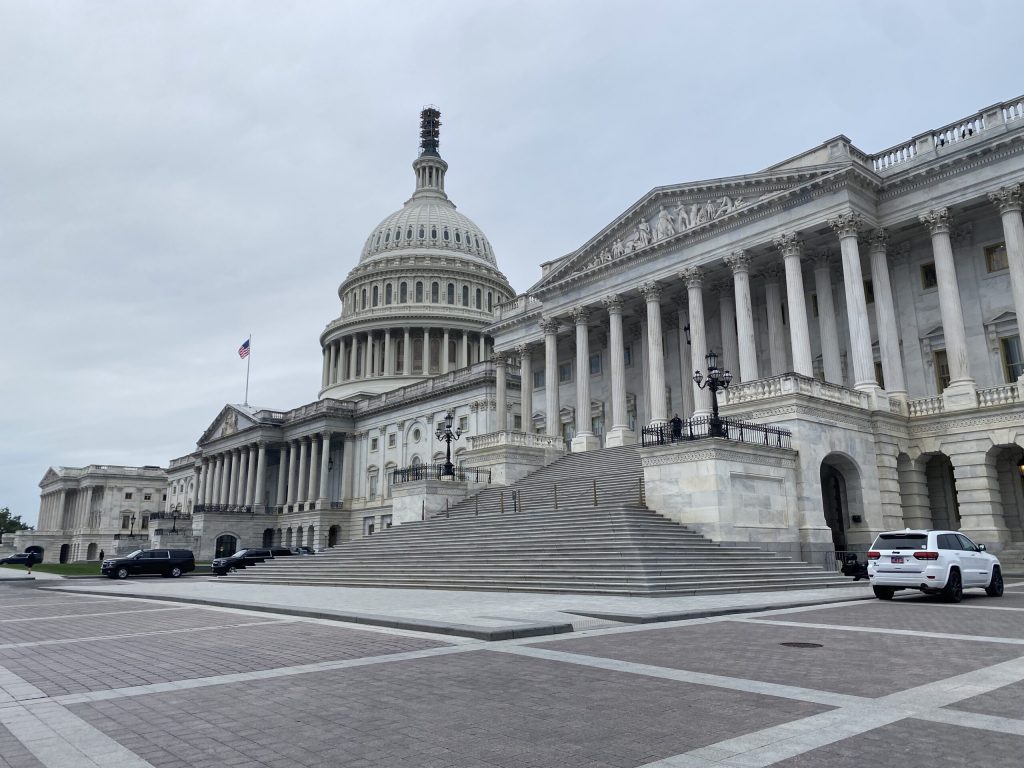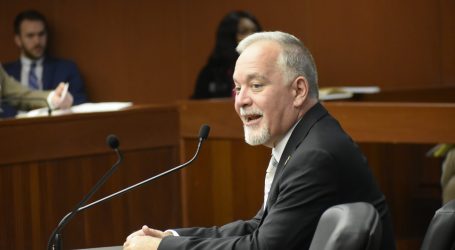A ‘chaotic’ January? Congress faces two shutdown deadlines with no action yet on spending

The spending stalemate has aggravated both Democrats and Republicans on the Senate and House Appropriations committees, who say leadership needs to give them the green light to begin talks ahead of the Jan. 19 deadline to enact four spending bills and the Feb. 2 deadline for the other eight appropriations measures. Shown is the U.S. Capitol. Jennifer Shutt/States Newsroom
WASHINGTON — Congress is staring down a funding cliff in mid-January and a second one in early February, but neither of those deadlines have inspired House and Senate leaders to broker agreement on the dozen bills that were supposed to become law by Oct. 1.
Appropriators are concerned the upcoming election year and competing legislative priorities have pushed their work to the back of the line, increasing the odds that Congress stumbles into a partial government shutdown in the new year.
The lawmakers who work on funding bills are equally frustrated that leaders may simply lean on a third stopgap spending bill to keep the government funded for the rest of the fiscal year, throwing months of work on the dozen full-year spending bills out the window.
Senate Appropriations Chair Patty Murray, D-Wash., said in mid-December that using a stopgap spending bill, also called a continuing resolution, to fund the government for the entire fiscal year would be “unprecedented and reckless.”
“We cannot just throw up our hands, act like nothing in the world has changed in the past 12 months, abdicate our responsibility to our constituents and box in our nation’s future by putting the government on autopilot,” Murray said.
Maine Sen. Susan Collins, the top Republican on the committee, has also rejected the idea of Congress using another continuing resolution, saying during a floor speech in late November the “temporary funding patches lead to harmful uncertainties, needless inefficiencies and wasted taxpayer dollars.”
“A year-long continuing resolution would simply fail to provide the resources needed to protect our nation,” Collins said.
A full-year stopgap spending bill would cut defense spending by $34.6 billion compared to what the Senate spending panel approved in its bipartisan bill, she said.
Senate Minority Leader Mitch McConnell, a Kentucky Republican, said Tuesday that using a continuing resolution to fund the government for the rest of the fiscal year is “unacceptable.”
“It’s devastating, particularly for defense and we’ve got all of these wars going on,” McConnell said. “So we need to reach an agreement on the topline and get about getting an outcome as soon as possible.”
Spending levels in debt limit deal
Congress and the Biden administration agreed to spending levels for fiscal year 2024, which began back on Oct. 1, as well as fiscal year 2025 when they brokered the debt limit deal last summer.
The Senate Appropriations Committee wrote all 12 of its annual government funding bills to roughly that level and the committee approved them all following broadly bipartisan votes.
The House spending panel, however, wrote its bills more than $100 billion below those levels and added in dozens of conservative policy changes that infuriated Democrats.
Those differing spending levels are among the many issues that have delayed the House and Senate from heading to conference committees to hammer out their differences.
Speaker Mike Johnson, a Louisiana Republican, said before that chamber left for a three-week winter break that he agreed the spending bills should be written to the funding levels in the debt limit law. But he argued the Senate bills are above those numbers.
“We’re awaiting the other team, the other side, the other chamber to come forward with a number that we can agree upon that we write to,” Johnson said. “And that’s the impasse and that’s what we’re waiting on. But the law is the law.”
Collins said Tuesday that her preference would be for the final bills to reflect the topline spending level in the debt limit law “plus the side deal plus filling in with some emergency spending that” she and Chair Murray agreed to.
The stalemate has aggravated both Democrats and Republicans on the Senate and House committees, who say leadership needs to give them the green light to begin talks ahead of the Jan. 19 deadline for four spending bills and the Feb. 2 deadline for the other eight appropriations measures.
Arkansas Republican Rep. Steve Womack, chair of the Financial Services spending panel, said last week that congressional leaders should have told the committee weeks ago what the total spending level would be for the current fiscal year, known as the topline.
“We’re just in a bad spot. We’ve needed these topline numbers,” Womack said. “I’m anxious to go home for Christmas, but at the end of the day, I know if they gave us a topline today, we are just going to absolutely kill our staffs. These do not happen overnight.”
‘Chaotic’ month predicted
Maryland Democratic Rep. Steny Hoyer, ranking member on the Financial Services spending panel, said January will be “chaotic” since the GOP leaders have “created a crisis.”
“They have created a chaotic, almost impossible situation for themselves and the country,” Hoyer said.
A shutdown, he said, is “more likely than it should be because of the timeframe and because of the irresolution and the deep division within the Republican Party.”
Kentucky Rep. Hal Rogers, the top Republican on the Commerce-Justice-Science spending subcommittee, said not having spending levels puts meeting the Jan. 19 and Feb. 2 deadlines in “severe jeopardy.”
Rogers said he believes Speaker Johnson understands the importance of getting agreement on the spending levels, but said that is challenging at the moment.
“I think he fully understands that,” Roger said. “But he’s got to put together the votes to make that happen.”
Montana Democratic Sen. Jon Tester, chair of the Defense spending subcommittee, said Congress should use the topline spending levels that were put in the debt limit law that Republicans and Democrats voted to approve.
“Toplines on appropriations, in my book, are set,” Tester said. “They were agreed to and the speaker of the House voted for them months ago. And to go back is really bad form, bad business, word is not your bond, very anti-Montanan.”
Tester said he would work to get agreement between the Republican House and Democratic Senate on his bill before funding expires on Feb. 2, but said he wasn’t sure that could happen.
“It’s got me very worried because there are no presents to open in January,” Tester said, alluding to the fact that Congress normally negotiates the bills ahead of the winter break.
The prospect of Congress using a stopgap spending bill to keep the government funded for the rest of the fiscal year doesn’t appeal to Tester, who said “God forbid” when asked about the possibility.
Oklahoma Republican Rep. Tom Cole, chair of the Transportation-HUD subcommittee, said using another stopgap spending bill, or a series of them, to fund the government — instead of passing the 12 full-year bills — is “very possible.”
“In some ways, it’s even the most likely, but it should not be the desired outcome,” Cole said.
The odds of a partial government shutdown beginning next year are low, Cole said, though he didn’t rule it out entirely.
Wisconsin Democratic Sen. Tammy Baldwin, chair of the Labor-HHS-Education spending subcommittee, said “there’s still nothing from the House” that would allow the chairs and ranking members to begin conference talks.
Given the time crunch, Baldwin said, the best option would be for the House to pass the dozen government funding bills the Senate Appropriations Committee approved earlier this year on broadly bipartisan votes.
GET THE MORNING HEADLINES DELIVERED TO YOUR INBOX
The post A ‘chaotic’ January? Congress faces two shutdown deadlines with no action yet on spending appeared first on Georgia Recorder.





